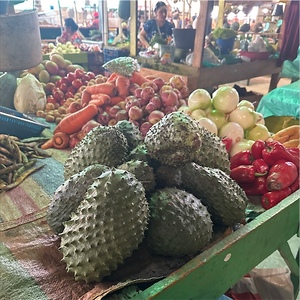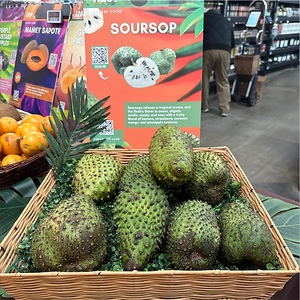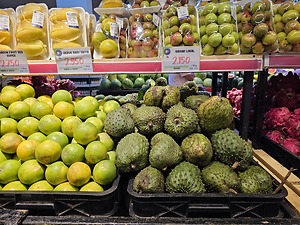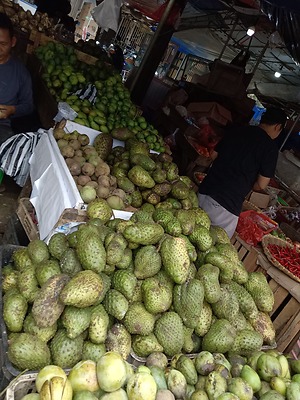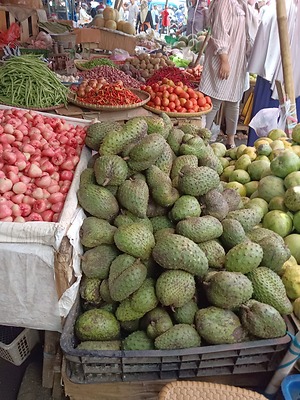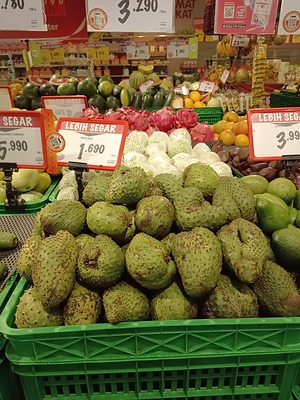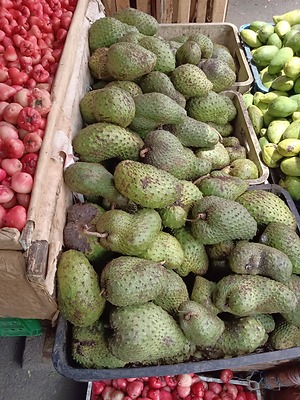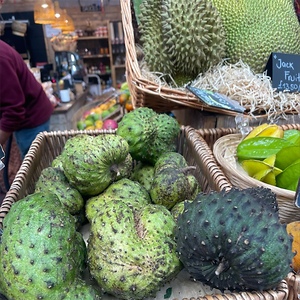

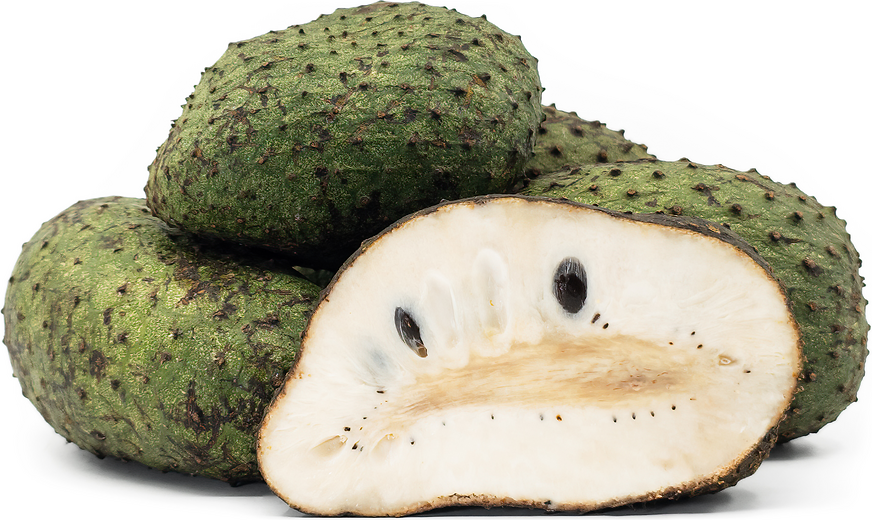
Soursop
Estimated Inventory, lb : 0
This item was last sold on : 05/04/25
Description/Taste
Soursops are medium to large fruits, averaging 10 to 30 centimeters in length and 12 to 15 centimeters in diameter, and have an irregular appearance, found in cordate, oval, to kidney-like shapes. The fruits can weigh up to 15 pounds and have semi-thin and leathery skin, covered in small to prominent spines. The spines are pliable and easily break off when the fruit is ripe, and the skin coloring transitions from dark green to yellow-light green with maturity. Underneath the surface, the white to ivory flesh is soft, granular, aqueous, and slightly fibrous when ripe. The flesh easily separates into pieces and surrounds a central, pithy core. The flesh also encases smooth, black, and hard, oval seeds ranging from 1 to 2 centimeters in length. The seeds are inedible and should be discarded during consumption, and there can be anywhere from 0 to over 200 seeds in each fruit, depending on size and variety. Soursops will lighten in color and change from firm to soft, giving slightly under pressure when ripe. The fruits release a tropical aroma, and the flesh's flavor is sweet, slightly acidic, musky, and sour with a fruity blend of banana, strawberry, coconut, mango, and pineapple nuances.
Seasons/Availability
Soursops are mostly available year-round in tropical climates. Every region varies with specific availability, but the fruit's peak season generally occurs from spring through the late fall.
Current Facts
Soursops, botanically classified as Annona muricata, are tropical fruits belonging to the Annonaceae family. The unusually shaped, sweet, and tangy fruits grow on evergreen trees reaching 6 to 9 meters in height and are the largest and most tropical species of the Annona genus. Soursops are named for their slightly acidic and sour taste, and the fruits originated in South America and the West Indies, later spreading worldwide. Soursop trees are commercially cultivated and found wild, and the trees are fast-growing, bearing fruit in 3 to 5 years. Despite their fast-growing nature, Soursops are low producers, bearing anywhere from 12 to 24 fruits per tree, and the trees are sensitive to temperature, soil, and other climate changes. There are many different varieties of Soursop found worldwide, and the fruits are known by regional names, including Guanabana, Guanaba in El Salvador, Cabeza de Negro or Zopote de Viejas in Mexico, Sorsaka or Zunrzak in the Netherlands Antilles, Huanaba in Guatemala, Graviola, Araticum do Grande or Jaca do Para in Brazil, Catuche or Catoche in Venezuela, Thu-rian-khack in Thailand, Corossol in Vietnam, and Durian Belanda in Malaysia. Soursop fruits are primarily enjoyed fresh and are consumed in desserts, beverages, and as a stand-alone snack.
Nutritional Value
Soursops are a source of fiber to regulate the digestive tract, vitamin C to strengthen the immune system, and iron to develop the protein hemoglobin for oxygen transport through the bloodstream. The fruits also provide calcium and phosphorus to build strong bones and teeth, potassium to balance fluid levels within the body, and other nutrients, including magnesium, B vitamins, zinc, and copper. Beyond vitamins and minerals, Soursop fruits contain antioxidants to protect the body against the damage inflicted by free radicals, helping to reduce inflammation. The fruits are also used in natural medicines worldwide as a topical and internal remedy for inflammation, digestive issues, and wounds.
Applications
Soursops have a tropical, sweet, and subtly acidic flavor suited for fresh and cooked preparations. The fruits are typically consumed straight out of hand when ripe and can be sliced in half, scooping the flesh out with a spoon. Only the flesh is edible, and the black seeds and skin should be discarded. Soursop flesh can be torn into segments, tossed into salads, mixed into fruit dishes, or served as a topping over sorbet, ice cream, yogurt, and chia pudding. The fruits are also blended and strained into a sweet juice, often mixed with milk, sugar, or water. It is common to see Soursop juices in street markets in Southeast Asia, the Caribbean, and Central and South America, and the juice is regarded as a sweet, refreshing pick-me-up. Soursop juice is combined into cocktails, smoothies, or steeped into a tea. In addition to juices, Soursop is popularly incorporated into custards, puddings, cakes, bread, ice cream, and mousse or mixed with gelatin as a light dessert. In the Caribbean, Soursop ice cream is frozen into ice cube trays or made into popsicles. The fruits can also be simmered into syrups, jellies, and jams or canned for extended use. Soursops pair well with other fruits such as pineapple, strawberries, bananas, and mangoes, vanilla, chocolate, brown sugar, and cream. Whole, unopened Soursops can be ripened at room temperature for a few days to soften the flesh. Once ripe, the fruit should be immediately consumed for the best quality and flavor. Ripe Soursops will keep for 2 to 3 days in the refrigerator. It is important to note that some fruits may turn black on their surface, but the flesh is still edible.
Ethnic/Cultural Info
Soursop fruits, flowers, and leaves have been a part of several folkloric uses to relax the body and release emotions. In the Complete Language of Herbs: A Definitive and Illustrated History, Soursop flowers and leaves are placed into sachets and worn on the body to release feelings of oppression and block overwhelming emotions. Soursop flowers are comprised of petals ranging 4 to 5 centimeters in length and have a triangular, fleshy appearance, showcasing bright yellow hues. The leaves are dark green, oval, and glossy with a small point. In the Netherlands Antilles, Soursop leaves are put into pillowcases or scattered across bedding, believing that the leaves will bring relaxation and restful sleep. One of the more unusual uses of Soursop leaves is mentioned in a Materia Medica from British Guiana. Materia Medica is a collection of records used to document natural remedies. In the book from British Guiana, Soursop leaves are used as a hangover remedy. The leaves are swished, squeezed in water, and then rubbed on an intoxicated individual's head. The leaf-infused water is also consumed, believing it will bring soberness.
Geography/History
Soursops are native to regions of South America and the West Indies and have been growing wild since ancient times. The fruits thrive in tropical, humid lowlands and were spread in the early ages throughout Central America, the Caribbean, and into Mexico, where the trees became quickly naturalized. Soursops were one of the first fruit trees introduced from the New World to the Old World, planted throughout Asia, Southeast Asia, and tropical Africa, and were later carried to Australia. Today Soursops are found growing wild and are cultivated in tropical regions worldwide, sold through local markets, specialty distributors, and select farmers markets.
Recipe Ideas
Recipes that include Soursop. One



